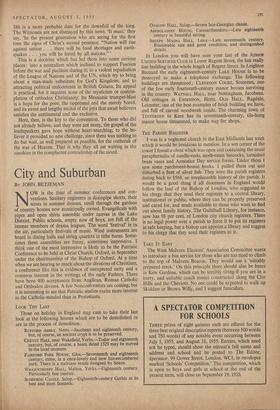City and Suburban
BY JOHN BETJEMAN Now is the time of summer conferences and con- ventions. Sanitary engineers in drainpipe shorts, their wives in summer dresses, stroll through the gardens of country houses now municipally owned. Evangelicals with pipes and open shirts assemble under canvas in the Lake District. Public schools, empty now of boys, are full of the intense members of drama leagues. The word 'festival' is in the air, particularly festivals of music. Wind instruments are heard in dining halls and string quartets in tithe barns. Some- times these assemblies are funny, sometimes impressive. 1 think one of the most impressive is likely to be the Patristic Conference to be held at Christ Church, Oxford, in September under the chairmanship of the Bishop of Oxford. At a time when we are hearing so much aboutthe divisions of Christians, a conference like this is evidence of unexpected unity and a common interest in the writings of the early Fathers. There have been 400 acceptances from Anglican. Roman Catholic and Orthodox divines. A few Nonconformists are coming, but it is interesting to see that Patristic studies excite more interest in the Catholic-minded than in Protestants.
LOOK DIY LAST Those on holiday in England may care to take their last look at the following houses which are to be demolished or are in the process of demolition : RUFFORD ABBEY, Notts.—Jacobean and eighteenth century, but, of course, an ancient crypt is to be preserved.
CHEVET HALL, near Wakefield, Yorks.—Tudor and eighteenth century, but, of course, a beam dated 1529 may be moved to the local museum.
FAIRFORD PARK House, Glos.—Seventeenth and eighteenth century, stone, in a once-lovely and now hut-encumbered park. There is a staircase inside designed by Soane.
WIGGENTHORPE HALL, Malton, 'Yorks.—Eighteenth century. Particularly fine interior.
SUNDORNE CASTLE, Salop.—Eighteenth-century Gothic at its best and most fantastic. ONSLOW HALL, Salop.—Severe late-Georgian classic.
ABEROLASNEY House, Carmarthenshire.—Late eighteenth century in beautiful setting.
SHEEPY MAGNA HALL, Leics.—Late seventeenth century. Reasonable size and good condition, and distinguished details.
In London you will have seen your last of the Jumost UNITED SERVICES CLUB in Lower Regent Street, the last really tine building in the whole length of Regent Street. In Leighton Buzzard the early eighteenth-century LAKE HOUSE is to be destroyed to make a telephone exchange. The following buildings are threatened : CLEVEDON COURT, Somerset, one of the few early fourteenth-century manor houses surviving in the country. WATNALL HALL, near Nottingham, Jacobean. Old cottages in ESSENDON, Herts. OLD HALL, Ragdale, Leicester, one of the best examples of brick building we have, and full of carved woodwork inside. The charming town of TENTERDEN in Kent has its seventeenth-century, tile-hung manor house threatened, to make way for shops.
THE PARISH REGISTER I was in a neglected church in the East Midlands last week which it would be invidious to mention. In a wet corner of the tower I found a chest which was open and containing the usual paraphernalia of candle-ends, moth-eaten hassocks, tarnished brass vases and Armistice Day service forms. Under them I saw some parchment-bound books. I pulled them out and disturbed a fleet of silver fish. They were the parish registers dating back to 1568, an irreplaceable history of the parish. It would be a good thing if all diocesans in England would follow the lead of the Bishop of London, who suggested to his clergy that they send their registers to a central library, institutional or public, where they can be properly preserved and cared for, and made available to those who want to find out about family history. The Guildhall Library, for instance, now has 98 per cent. of London city church registers. There is no legal power over a parish to force it to put its registers in safe keeping, but a bishop can appoint a library and suggest to his clergy that they send their registers to it.
TAKE IT EASY The West Malvern Electors' Association Committee wants to introduce a bus service for those who are too tired to climb to the top of Malvern Beacon. They would use a 'suitably prepared track.' On this principle there should also be buses in Kew Gardens. which can be terribly tiring if you are in a hurry, and suitable coach routes constructed along the Clee Hills and the Cheviots. No one could be expected to walk up Skiddaw or Brown Willy. and I suggest funiculars.


































 Previous page
Previous page